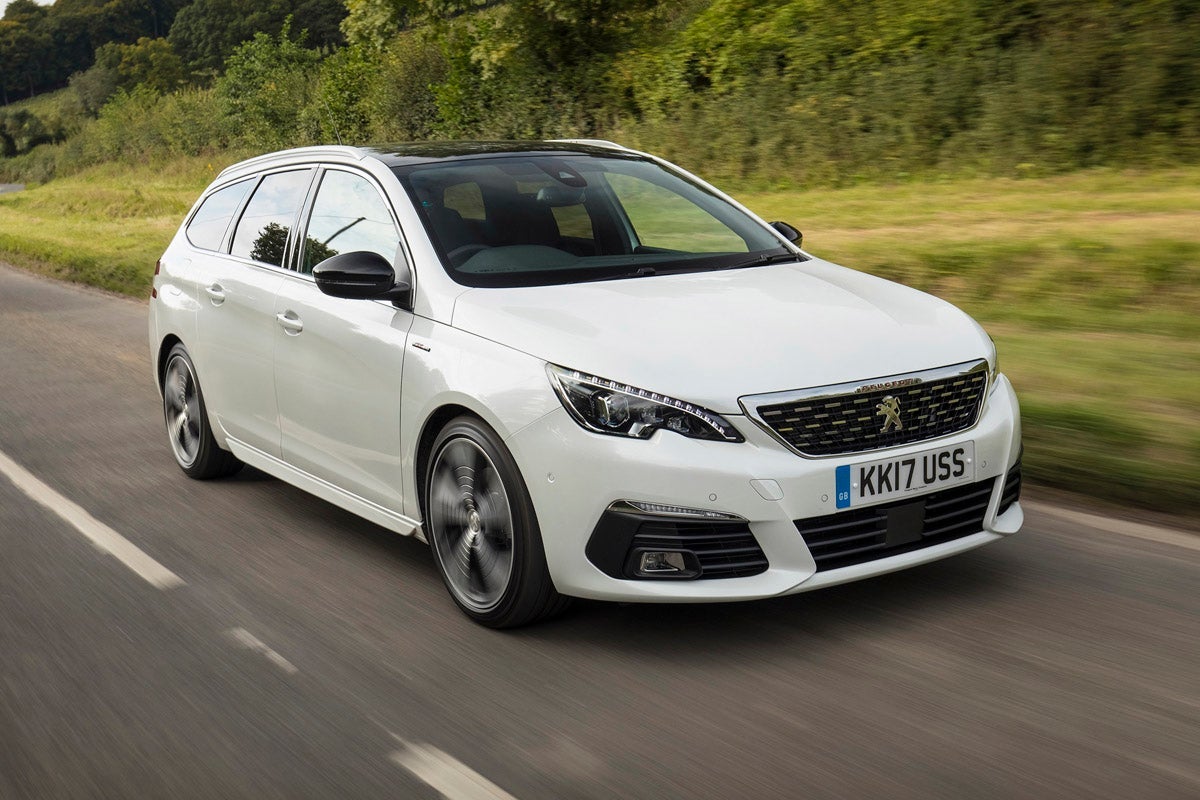Peugeot 308 SW (2014-2021) Review
Written by Andrew Brady
Quick overview
Pros
- Attractive inside and out
- Lots of space for luggage
- Impressive range of engines
Cons
- Firm ride on some roads
- i-Cockpit design won’t suit everyone
- Higher-spec models offer less value
Overall verdict on the Peugeot 308 SW
"In this Peugeot 308 SW review we are looking at a traditional compact estate car, something that has fallen out of favour in recent years but still has something to offer buyers. Peugeot has a good back catalogue of practical and attractive estate cars, and the Peugeot 308 SW is definitely one of them. Good to drive, spacious and comfortable, it has plenty of appeal and is a good ownership prospect. There are a few better alternatives, but it's still a worthy choice."
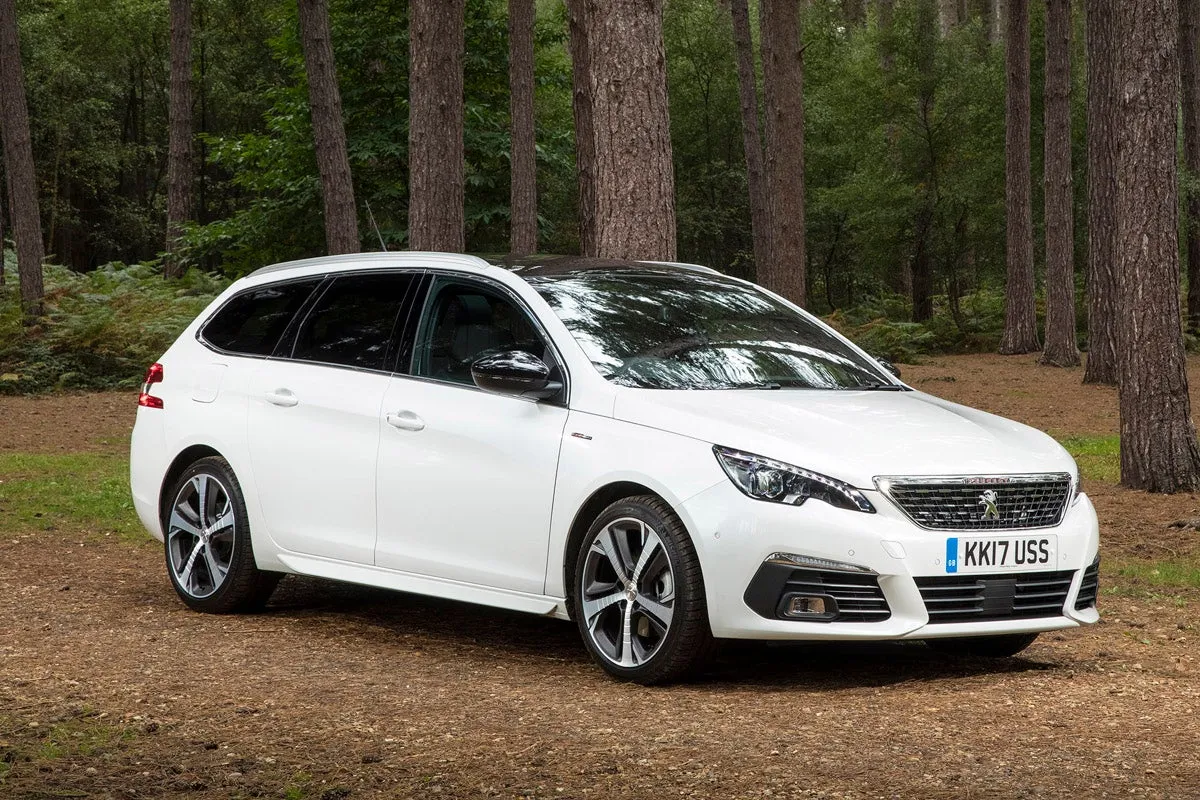
Peugeot might be most fondly remembered for its hatchback models - no review of one of its products is complete without a mention of the 205 - but it has a long history of producing family-oriented estate models as far back as the 1960s, and they have been amongst the brand’s best and most successful products. Following that legacy is the Peugeot 308 SW, an estate version of the impressive Peugeot 308 hatchback.
The first impressions are certainly good, and show that the hatchback’s eye-catching design was not a fluke. It avoids just looking like a regular hatch with an estate tailgate crudely grafted on and instead is something you might actually want to put on your driveway.
Inside it’s no less interesting. Like the rest of Peugeot’s more recent models, the Peugeot 308 SW has what the company calls its i-Cockpit interior. What that means is that the steering wheel is deliberately smaller in diameter than normal so you view the instrument display - analogue or digital depending on the model - over the top of the wheel instead of behind it. It also means that almost all the car’s functions are controlled via a touchscreen system, so there are very few buttons elsewhere in the cabin.
Of course, being an estate the Peugeot 308 SW has to deliver in terms of space, and it has a lot of it to offer. It’s one of the roomiest estates in the class, with up to 1,775 litres of boot space with the rear seats folded. There’s good space for passengers too, so as a family machine or a load-carrying hack the Peugeot 308 SW has plenty going for it.
As for engine choices, the Peugeot 308 SW has a broad mix of petrol and diesel units in terms of cost and performance. There is a 1.2-litre petrol in 110PS and 131PS forms, as well as a powerful 1.6-litre petrol with 227PS in the GT model, while on the diesel front you have a choice of a 1.5-litre in 101PS and 130PS outputs (131PS with the automatic gearbox) as well as a 2.0-litre diesel with 177PS.
To drive, the Peugeot 308 SW leans a little towards the sporty side of things. Even if you go for a basic version, the steering feels quick in your hands (partly because of the wheel's so small) and it is keen to turn into a bend. The downside of this is that the ride quality is not as good as the best cars in the class – such as the Volkswagen Golf – so it is a compromise you should consider before buying.
There’s a lot to like about the Peugeot 308 SW. It’s attractive inside and out, has a range of modern, efficient engines and is good to drive. It’s also very spacious, which is surely the point of an estate in the first place.
Looking for the newer version, you need our Peugeot 308 SW review.
Is the Peugeot 308 SW right for you?
If you’re looking for an estate car that offers a generous amount of load space but also doesn’t look like a badly-disguised van - or drives like one - then the Peugeot 308 SW is worth your consideration. As a family car it has the versatility and flexibility that is essential to making your life easy, or if you need to carry heavy loads long distances on a regular basis it has the space and the performance, although its comfort levels aren’t as high as in some rivals.
The Peugeot 308 SW also makes a good choice if you want a car that is entertaining to drive with strong performance as well as being practical. The GT is considerably more expensive than the standard car but is entertaining and still offers all the practicality of the regular version.
What’s the best Peugeot 308 SW model/engine to choose?
With so many engine options to choose from it’s important to consider what kind of driving you will be doing. If it’s lots of urban running around and carrying bulky rather than heavy loads then one of the 1.2-litre petrol would make a good choice - they offer sufficient performance but are frugal and quiet too. If you plan on doing more long journeys and carrying heavier loads, the 130PS version of the 1.5-litre diesel is a sound choice, with good low-down pulling power and impressive fuel consumption.
As for trim levels, the standard specification is quite generous, with things like the infotainment system including DAB, sat nav and MirrorLink as standard as well as cruise control, climate control and parking sensors on every model, so there’s no harm in sticking with the basic Active model. The next version up doesn’t add much significant equipment other than bigger alloy wheels and sports seats but will be more expensive.
What other cars are similar to the Peugeot 308 SW?
There’s no shortage of rivals for the Peugeot 308 SW, as the compact estate segment is almost as competitive as the hatchback class that these models are derived from. The Ford Focus Estate and Vauxhall Astra Sport Tourer both offer good value, decent interior and boot space and an appealing driving experience. We'd also look at the Honda Civic Tourer and the Renault Megane Sport Tourer.
Volkswagen’s Golf Estate is a little more expensive but has a high quality cabin and is also great to drive, while the Skoda Octavia Estate has a huge load space and high equipment levels. There's also the latest SEAT Leon Estate, so you are definitely spoiled for choice.
Comfort and design: Peugeot 308 SW interior
"If you’ve not been on the inside of a modern Peugeot recently then climbing into the Peugeot 308 SW will come as something of a culture shock. While everything in here is roughly where you’d expect it to be, the Peugeot 308 SW takes quite a radical approach."

While every other car in the class has you viewing the instruments through the top of the steering wheel, the Peugeot 308 SW has a much smaller wheel and puts the instrument display high up on the dash, so whatever driving position you have you’re viewing the instruments over the top of the wheel instead. In addition, the i-Cockpit arrangement moves a number of functions to the touchscreen system, so that the dashboard is quite clean in its appearance with few buttons on display.
Whether this arrangement is a positive is very much a matter of personal opinion. Once you’ve put the steering wheel and the seat in the position that suits you in relation to the pedals, you may find that the wheel is actually blocking your view and you have to adjust it to a different position, or it may suit you perfectly; it’s very much something you need to experience for yourself.
Similarly, moving many of the functions to the touchscreen has both positives and negatives. The clean look of the fascia is appealing, and when you’re on the move there is little to distract you from the road ahead. On the other hand, it is an irritation to have to activate the touchscreen in order to adjust the ventilation controls, a function which is usually controlled by conventional hard buttons or knobs.
Quality and finish
Even among the brands that are not pitched as being premium there are some high standards in this class, and the Peugeot 308 SW finds itself in the middle of the pack rather than out in front. There’s no doubt that the materials in the cabin look attractive; although it’s mostly dark greys and blacks in here, there are lots of metal-effect details and areas of gloss piano black that break up the uniformity, and the fact that the interior has quite a minimalist approach also boosts the impression of quality.
Get a little closer and start to use the interior functions and the overall impression is a little more mixed. Plenty of the materials are of good quality and soft to the touch, but there are also several areas where cheaper, harder plastic has been used and it isn't very well hidden either. What few buttons there are feel reasonably robust but not especially pleasant to the touch. There are better cars in the segment in this respect, although they may cost a little more to buy.
Infotainment: Touchscreen, USB, nav and stereo in the Peugeot 308 SW
The quality and the specification of the Peugeot 308 SW’s infotainment system is impressive. All models are fitted with a 9.7-inch touchscreen including DAB, Apple CarPlay and Android Auto, voice recognition and sat nav provided by TomTom, including three years of live services from new. There are few options to upgrade the system or differences between the trim levels such is the high standard specification - all you can add is a premium audio upgrade and a subscription for speed camera detection.
The system itself works very well. The graphics are sharp and the response of the screen itself is quick and accurate; it has a capacitive function so there is a degree of feedback when you touch the screen which is helpful when you are on the move.
On the downside it can be counterintuitive to have to go through the screen’s systems to operate basic functions, in particular changing the settings for the climate control may be on the home screen but this is still more effort than using hard keys, particularly when you are behind the wheel. A Volkswagen Golf Estate is better when it comes to usability.
Space and practicality: Peugeot 308 SW boot space
All of the competitors in the compact estate segment offer a decent level of interior space, but some buyers will want the maximum possible boot space while others will prioritise passenger accommodation; the Peugeot 308 SW is significantly biased towards the former.
Front seat passengers are well catered for. There is a generous amount of headroom and legroom, with a large range of adjustment in the seats (seat height adjustment is standard for the passenger as well as the driver) and plenty of width across the cabin too. If you need a family car and have two small children, you can enjoy the front seat space while your smaller passengers are comfortable in the back.
If you need to carry adults in the back of the Peugeot 308 SW you should expect some grumbles of discontent. Space has been compromised in favour of boot room, and while that will be inconsequential for some buyers, your mates will be disappointed by the amount of legroom available; you don’t even need to be particularly tall to be bothered by the seat back of the front passengers. Headroom is actually quite generous, and although three adults is a bit of a squeeze, two across the second row is perfectly possible.
The flip side of the below-average rear legroom is a boot space that is particularly large, even in comparison with the best cars in the class. With the rear seats up the Peugeot 308 SW offers an impressive 660 litres of space, more even than the Skoda Octavia (which admittedly has a lot more rear legroom) and the same as the giant Skoda Superb offers, while with the seats folded down this increases to 1,775 litres, also more than the Octavia offers to make it one of the most spacious cars in the class. The space itself is well shaped, there are levers to drop the backrests from the boot and there is a standard 60/40 split too.
The Peugeot 308 SW dimensions are 4585mm long, 2043mm wide and 1461mm tall.
Handling and ride quality: What is the Peugeot 308 SW like to drive?
"For many years Peugeot has had a reputation for producing cars that offer good handling and ride, even if that particular segment is not one that is normally associated with dynamically excellent cars. The Peugeot 308 SW goes a long way to maintaining that reputation, and keener drivers will find it a satisfying car to drive, although this does come with a degree of compromise."
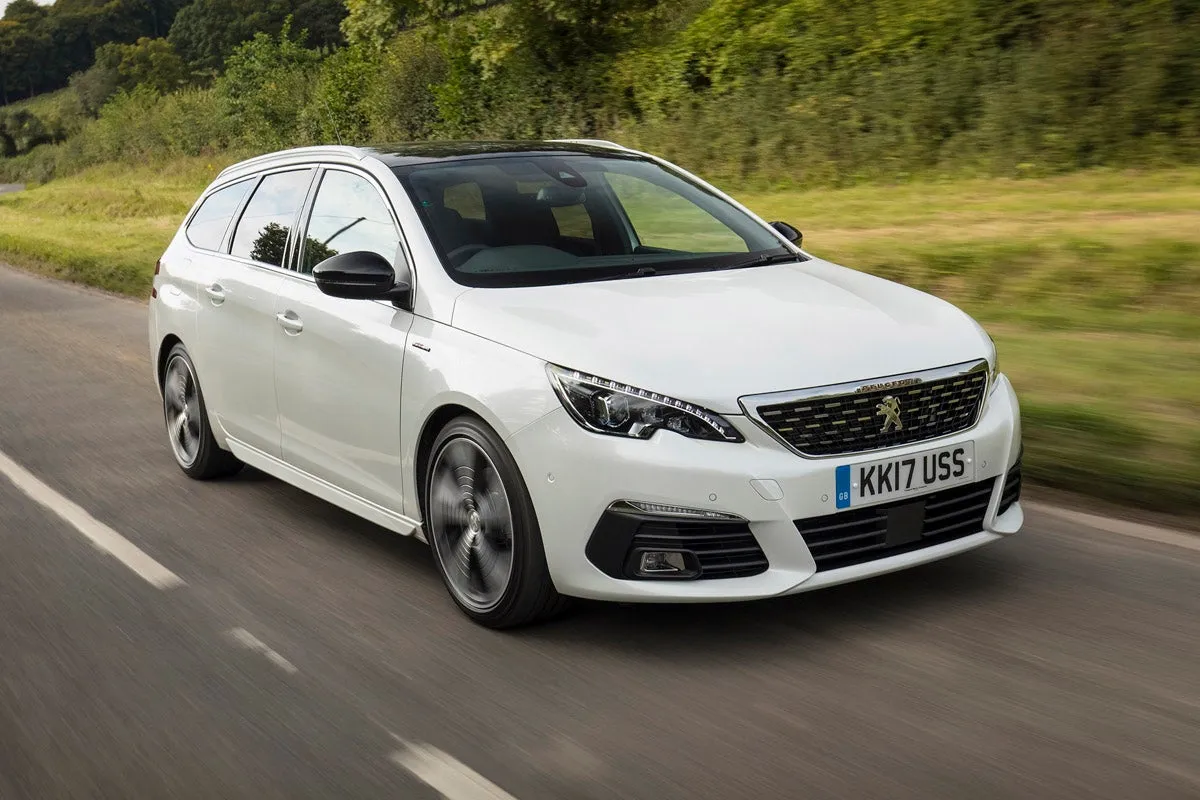
Even if you choose the basic Allure specification that is fitted with the smallest alloy wheels, the ride quality of the Peugeot 308 SW is somewhat mixed. Like any car should be, it is comfortable and smooth on well-surfaced roads, but once the quality of the asphalt begins to deteriorate it is quickly transmitted into the cabin with detectable jiggles over smaller imperfections. Models with larger alloy wheels are affected even more significantly, so that small bumps result in a significant amount of fidget from the suspension and larger bumps create a significant disruption.
The GT model also features lowered suspension which compounds the problem further. The ride quality of the Peugeot 308 SW is not unacceptable poor, it is just some distance behind the better cars in this class and many of them – such as Volkswagen Golfs fitted with more powerful (150PS and upwards) engines – are also fun to drive without such a significant compromise.
Where the Peugeot 308 SW claws back some credibility is when driven with a degree of vigour. The small steering wheel and its quick responses come into their own when you start to press on, and the eagerness of the Peugeot 308 SW to turn into a corner makes it a lot of fun. There is plenty of grip on offer whichever wheel and tyre combination is fitted, and there is little in the way of body roll either. It may not be the absolute best driver’s car in the class, but it is decent.
What engines and gearboxes are available in the Peugeot 308 SW?
With so much engine choice you have the luxury of picking one to suit your needs, whether economy, performance or pulling power is the most important factor.
Despite their size, the 1.2-litre petrols are very capable engines. The 110PS is no fireball, but has sufficient performance to keep up with traffic and be reasonably comfortable out on the motorway, it’s also quite economical and quiet too. For a little more punch the 130PS version is ideal, so much so that you’ll easily forget its small capacity. You have to pay extra for it of course, but it is similarly economical too, so it’s a worthwhile trade-off.
The 1.5-litre diesel in 100PS form is surprisingly capable, and while it is not particularly fast it does have a useful amount of torque at low engine speeds so it is capable of carrying heavier loads without affecting performance. It’s also comfortably the most economical option of all the engines. However, we’d suggest going for the more powerful 130PS version if you plan on doing a lot of load-lugging - it has 300Nm of torque, 20 per cent more than the 100PS version, and it’s almost as economical too.
The 2.0-litre diesel is a fine engine but it comes with an automatic gearbox only, and the 1.5-litre version are so capable it is not really worth the extra expense.
Refinement and noise levels
As is often the way, the most refined engine options in the Peugeot 308 SW are the petrols. Both versions of the 1.2-litre unit are impressively quiet, and don’t even cause much of an audible fuss when they are revved hard. Despite being three cylinder units there is not a great deal of vibration either, and so offer a high level of refinement in all conditions.
Both the 1.5-litre and 2.0-litre diesel units are less refined than the petrol alternatives. There is a bit of vibration coming through at idle speeds, and some noise coming through when they are extended, but both are quieter when at cruising speeds. None of the diesel options are so gruff that they should be avoided, but if you are torn between petrol or diesel then it may be an important factor in your decision making.
The Peugeot 308 SW’s mixed ride quality also translates to quite a bit of noise coming through into the cabin, whether from sharper bumps or the rumble of the tyres on the road surface. The Peugeot 308 SW also suffers from wind noise, although this only really becomes apparent when travelling at higher speeds.
Safety equipment: How safe is the Peugeot 308 SW?
Euro NCAP tested the Peugeot 308 in 2013, and although it was the hatchback model that was tested the organisation declared that the results also applied to the SW model. The 308 was awarded a full five-star rating by Euro NCAP, with an exceptionally high score of 92 per cent for adult occupant protection. Child occupant protection was rated at a strong 79 per cent, with pedestrian mitigation at 64 per cent and safety assist at a very high 81 per cent.
As standard, all versions of the Peugeot 308 SW are fitted with front head airbags for the driver and passenger, side chest airbags for the front seat occupants and curtain airbags for those in the front and rear. A knee airbag for the driver is not available as standard or as an option. Seat belt pre-tensioners are fitted for those in the front seats, with load limiters for both front and rear rows. ISOFIX child seat mounting points are fitted in the two outer rear seats with an airbag deactivation switch in the front passenger seat.
On the safety assist side, all versions of the Peugeot 308 SW are fitted with ESC and a speed limiter as standard, while there are three safety packs also available as an option; the Driver Assist Pack includes automatic emergency braking and adaptive cruise control, the Safety Pack includes driver attention alert, speed limit recognition and active lane assist, while Safety Pack Plus combines the two packs. It is only available on higher-specification models however.
MPG and fuel costs: What does a Peugeot 308 SW cost to run?
"Almost all the engine options in the Peugeot 308 SW range offer impressively low fuel consumption. The 100PS and 130PS 1.2-litre engines have a claimed combined fuel consumption figure or 51mpg and 52mpg respectively under the tougher WLTP rules, so you should be able to achieve 40mpg and more without too much effort."
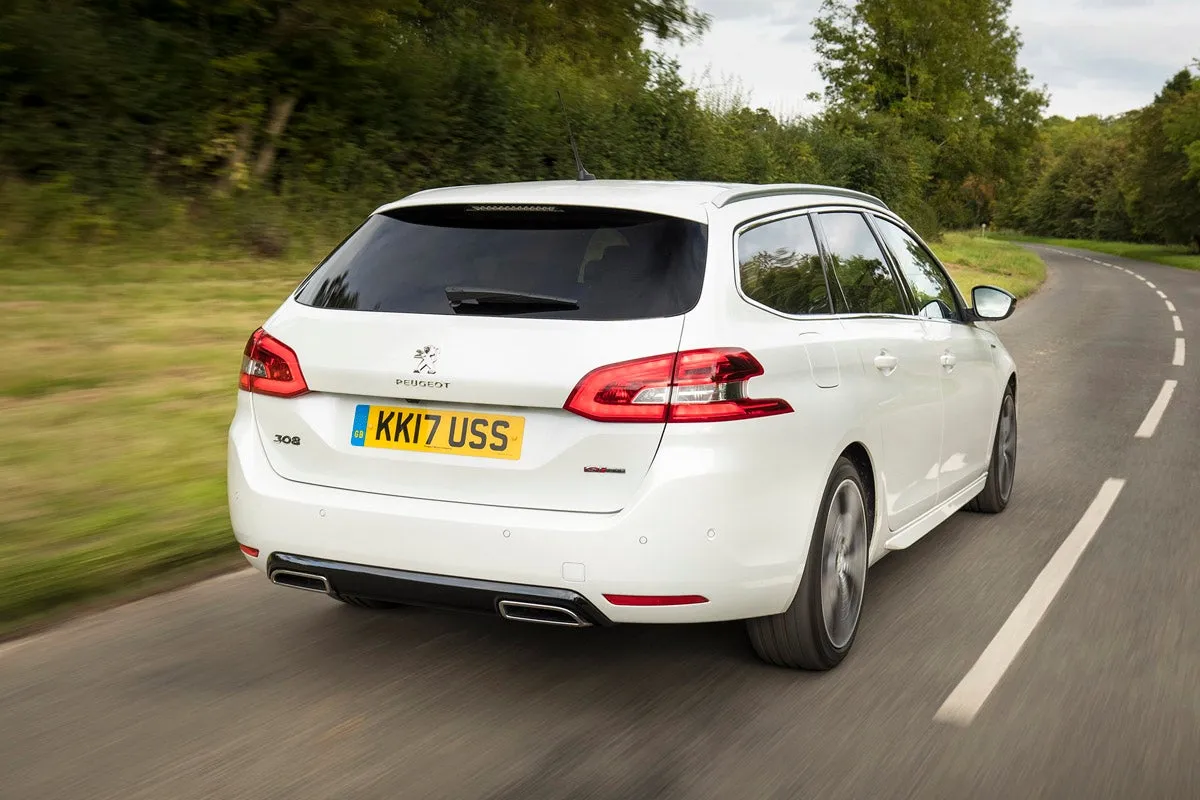
The diesel options are still more impressive, with the 100PS 1.5-litre claiming 64.6mpg combined and 62.7mpg for the 130PS version, which should mean that 50mpg is achievable on a regular basis. The more powerful 2.0-litre and automatic-only 180PS diesel claims 52.5mpg.
How reliable is a Peugeot 308 SW?
The Peugeot 308 scored a disappointing 8.61 out of 10 for reliability in the HonestJohn.co.uk Satisfaction Survey, making it one of the worst-performing cars in the whole Peugeot range. Owners have cited issues with electrical issues, DPF filters on diesel cars and cooling issues on some models, so if you are considering one ensure it has a full dealer service history.
As a brand Peugeot also performed poorly, finishing 24th overall out of 30 manufacturers overall.
Insurance groups and costs
The Peugeot 308 SW can be a relatively cheap car to insure, although the insurance groups it appears in vary significantly depending on which engine you choose. Go for the least-powerful 1.2-litre in basic Active trim and it falls into group 14 or 15; the same engine in 130PS form is in group 20, while the 1.5-litre diesel is group 17 for the 100PS version and group 21 for the 130PS version. The 2.0-litre diesel is significantly higher again, falling into group 24.
VED car tax: What is the annual road tax on a Peugeot 308 SW?
Because of its impressively efficient engines and the fact that it has been on sale since 2014, some versions of the Peugeot 308 SW qualify for low or even no VED. Post April 2017 models are taxed at the current rate, which means a flat rate of £165 per year across the range. Go for a model registered before April 2017 and you can make a saving, although it is important to note that the engine and model range was slightly different; the 1.6-litre BlueHDi diesel engine qualifies for zero VED, as do some versions of the 1.2-litre petrol (called e-THP at the time).
How much should you be paying for a used Peugeot 308 SW?
"The Peugeot 308 SW has been on sale for several years and is still being sold as a new model, so there are a range of ages and specifications available."
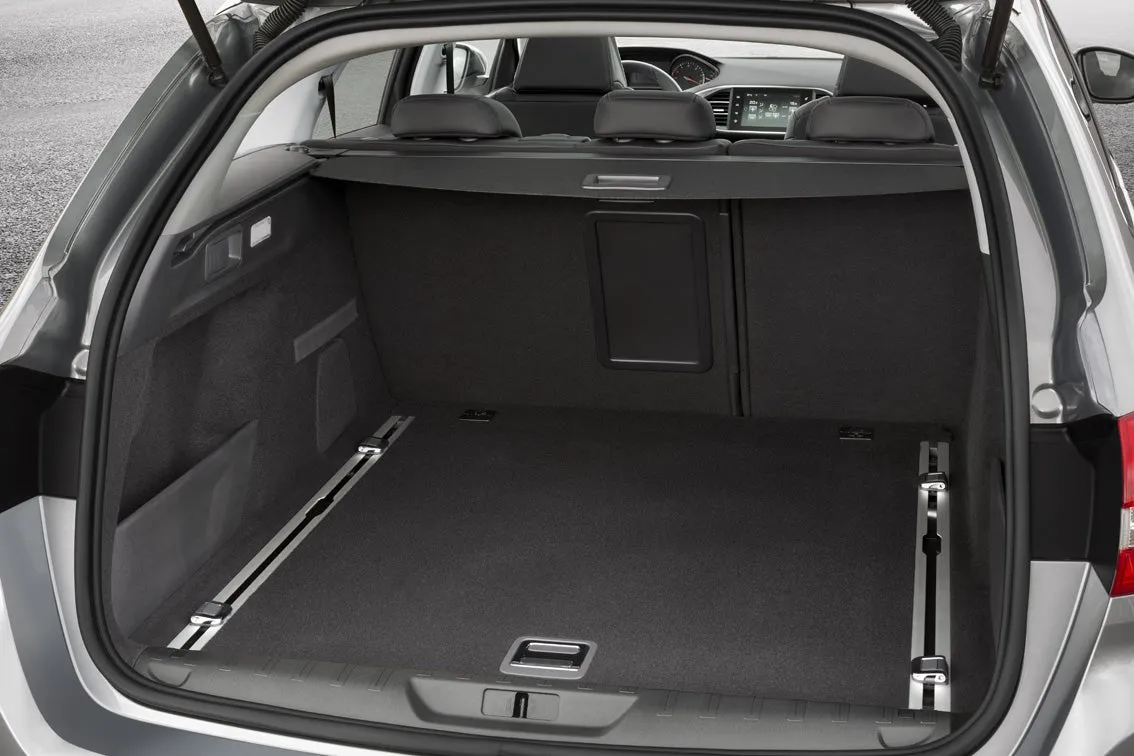
At the newer end of the scale there are bargains to be had; a quick search of the classifieds turned up several examples with very low mileage, including a 2020-registered 1.2 PureTech with less than 5000 miles for just £20,000."
At the older end of the scale, the earliest cars are now available for very little money. We found a 2016 1.6 HDi Active model with 55,000 miles for just £8,000, or a 1.2 PureTech 110 in Allure specification with only 30,000 miles for £7500.
Trim levels and standard equipment
The Peugeot 308 SW Active trim includes 16-inch alloy wheels, 9.7-inch multifunction colour touchscreen, satellite navigation, USB input, automatic dual-zone air conditioning, cruise control and speed limiter, rear parking aid, leather steering wheel & gearstick, automatic headlamps and automatic wipers.
Peugeot 308 SW Allure trim adds front fog lights, full LED headlamps, aluminium roof rails, aluminium boot rails, electric folding door mirrors, automatic dual-zone air conditioning, front parking aid and reversing camera plus 17-inch alloy wheels.
Peugeot 308 SW GT Line adds 18-inch alloy wheels, tinted rear windows, twin exhaust and black lacquered rear diffuser, aluminium style pedals and door sills, half alcantara trim sports seats with red stitching, driver and front passenger lumbar adjustment and massage function, GT style leather steering wheel with red stitching along with GT style carpet mats.
Peugeot 308 SW GT trim adds sequential LED direction indicators, GT style leather steering wheel with red stitching and GT badge, Driver Sport pack (increased responsiveness of power steering, engine and gearbox to accelerator pedal, red instrument panel display of dynamic parameter information: acceleration, power delivery and turbo), keyless entry, dynamic cruise control, emergency collision alert and an emergency collision braking system.
Ask the heycar experts: common questions
What does SW mean on a Peugeot 308?
Are Peugeot 308s reliable?
What are the common problems with the Peugeot 308?
Get our latest advice, news and offers
Keep me updated by email with the latest advice, news and offers from heycar.
By submitting you agree to our privacy policy
